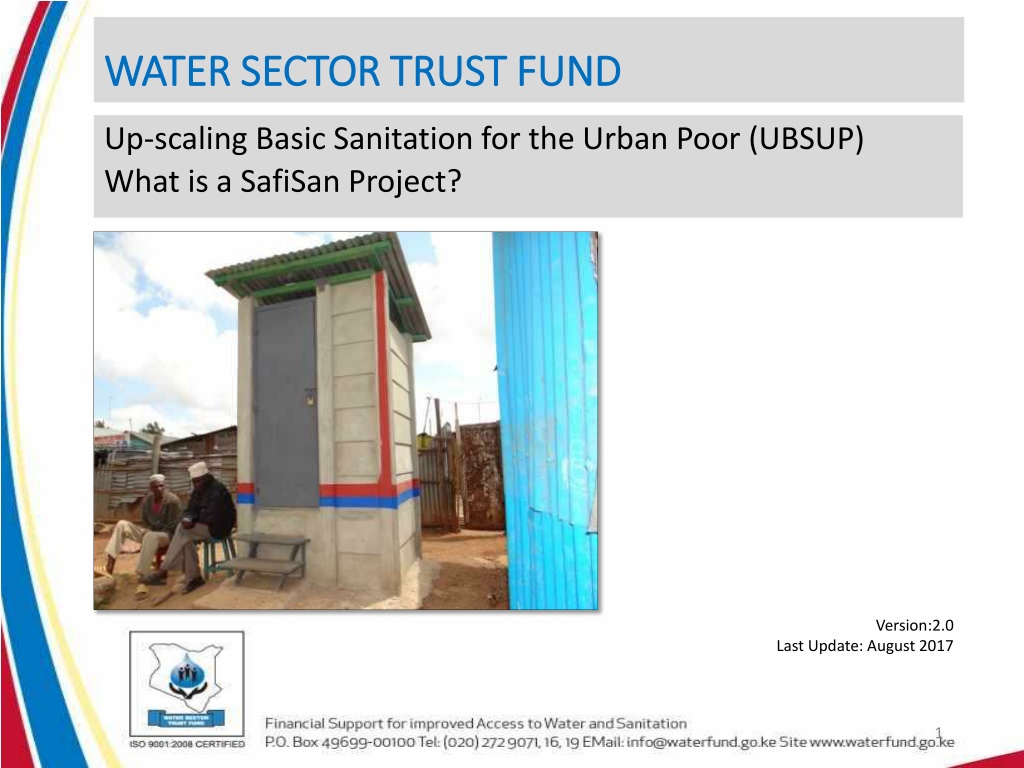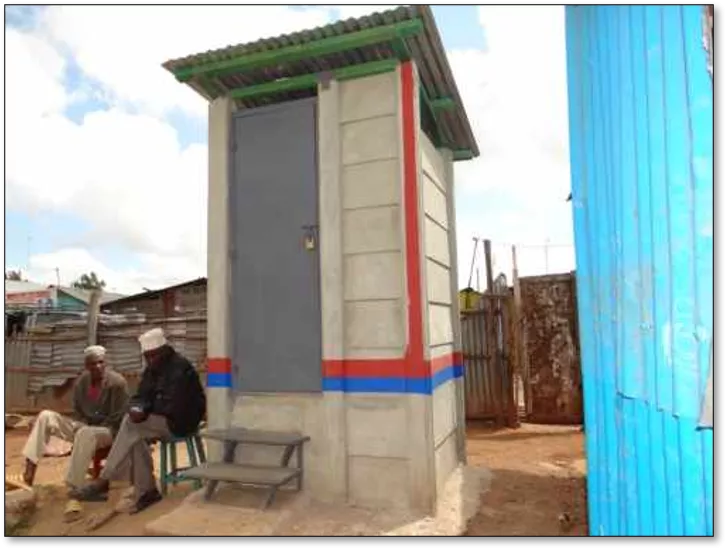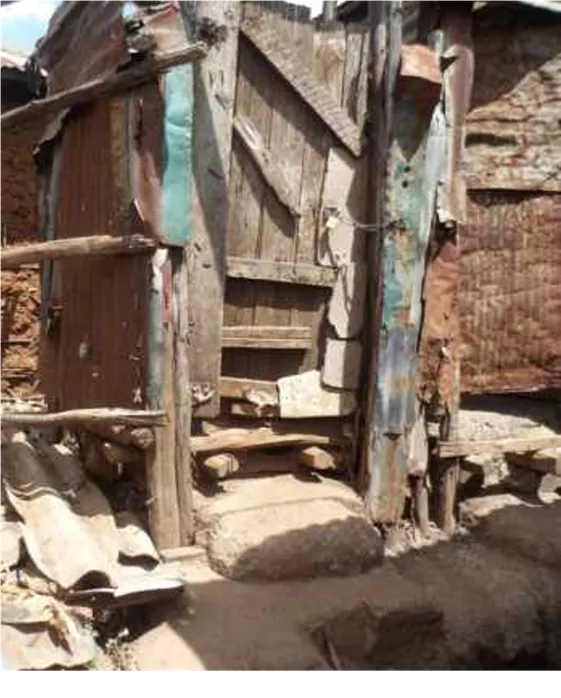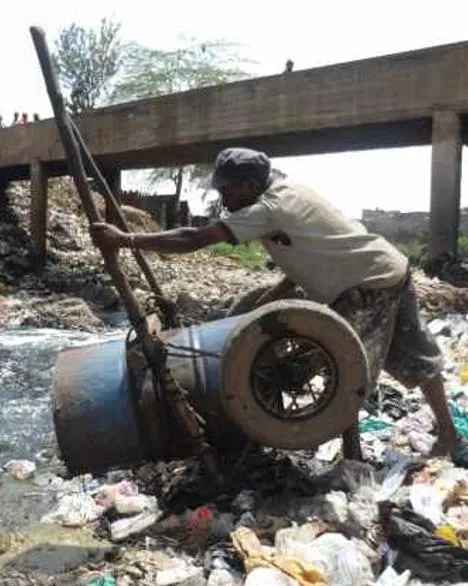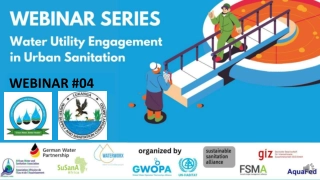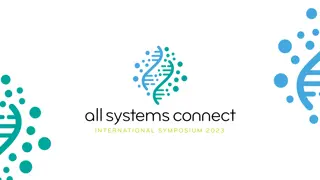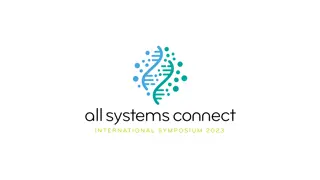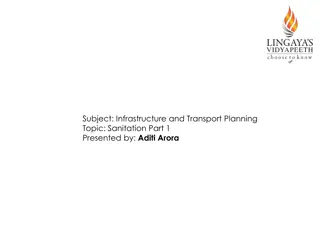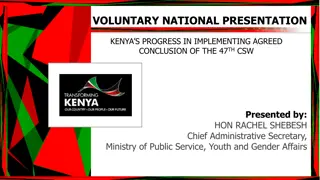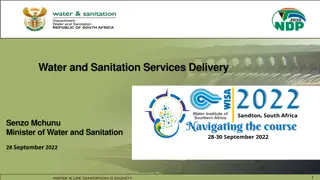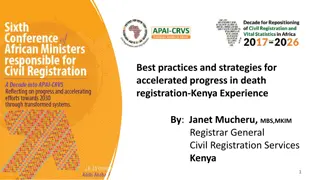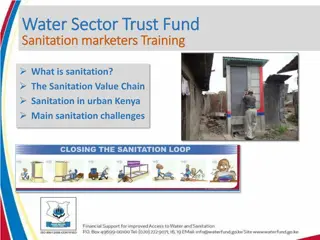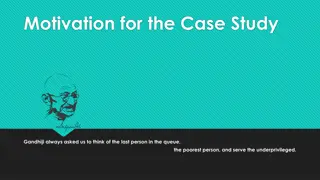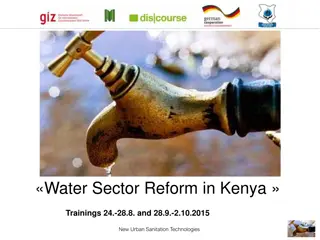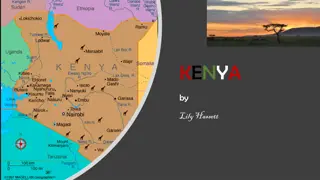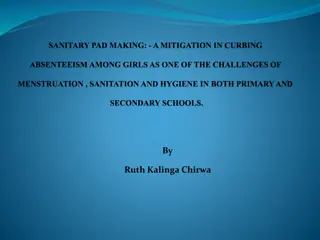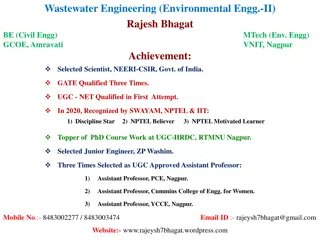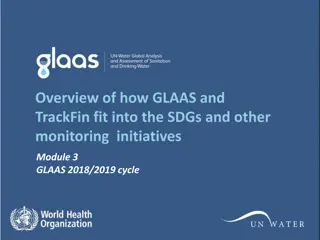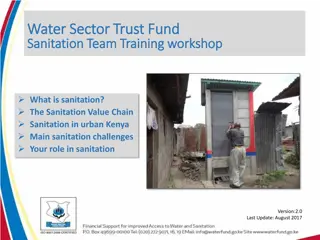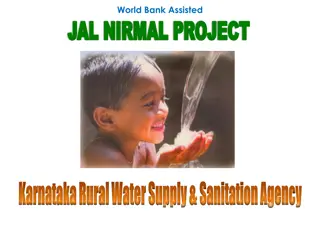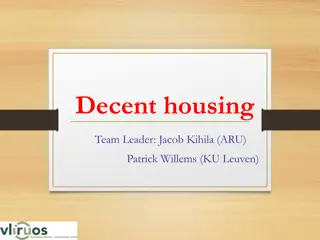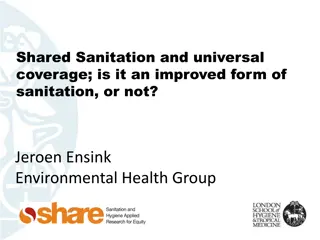Challenges in Sanitation in Kenya
Sanitation challenges in Kenya include biased government priorities, poor monitoring, lack of sewerage infrastructure, insufficient space, and low morale among manual emptiers. Addressing these challenges is crucial for improving public health and hygiene standards in low-income urban areas.
Download Presentation

Please find below an Image/Link to download the presentation.
The content on the website is provided AS IS for your information and personal use only. It may not be sold, licensed, or shared on other websites without obtaining consent from the author.If you encounter any issues during the download, it is possible that the publisher has removed the file from their server.
You are allowed to download the files provided on this website for personal or commercial use, subject to the condition that they are used lawfully. All files are the property of their respective owners.
The content on the website is provided AS IS for your information and personal use only. It may not be sold, licensed, or shared on other websites without obtaining consent from the author.
E N D
Presentation Transcript
WATER SECTOR TRUST FUND WATER SECTOR TRUST FUND Up-scaling Basic Sanitation for the Urban Poor (UBSUP) What is a SafiSan Project? Version:2.0 Last Update: August 2017 1
The name SafiSan Derived from Safi (Swahili word meaning clean) and sanitation (English word meaning hygienic management of human faeces) 2/24/2025 2
When it comes to sanitation, what are some of the challenges that we face??? 3
Sanitation challenges in Kenya Biased government priorities on sanitation - A largely focused effort on improved water supply as opposed to improved sanitation; no proactive policies for low income areas Most resources/ funding set aside for sanitation have been assigned for hygiene education. Toilet construction has never been a priority Split sanitation sub-sectors (in different ministries) yet, without a common command centre; each group without clear understanding of the depth and responsibilities. 4
Sanitation challenges in Kenya Poor sanitation monitoring hence non adherence/ignorance to laid down regulations on toilets (particularly in low income areas) and waste disposal Lack of sewerage infrastructure by the WSP owing to high costs of investments Large and increasing densities coupled increasing rural (urbanization - 4.2% p.a.) Landlords have priority in making more houses at the expense of toilets construction construction population an migration with urban ever 5
Sanitation challenges in Kenya Lack of space in densely populated low income urban areas Lack of designs/technologies for sanitation in the Kenyan market Lack of unified platforms for sharing best practices/approaches sanitation that would promote wider up-scaling Low status and poor morale of manual emptiers due to unsafe/ unhygienic, transportation and disposal practices low cost in emptying, 6
What is the Water Sector Trust Fund? WSTF is the pro-poor basket fund of the water sector which is successfully up-scaling water supply and public sanitation in urban low income areas through the Urban Projects Concept (UPC) window To address the sanitation challenges, the WSTF has developed a concept for up-scaling basic household and plot level in low income urban areas implemented between 2013 and 2016. This is known as the UBSUP/SafiSan programme sanitation at which will be 7
Water Sector Trust Fund The UBSUP/SafiSan programme is implemented through UPC which has a proven track record in implementing projects with the WSP s The project is funded by KfW and the Bill and Melinda Gates Foundation (BMGF) with technical support from the German International Cooperation (GIZ) 8
What is UBSUP? Upscaling Basic Sanitation for the Urban Poor A six-year programme (2011- 2017); project financed through the Water Services Trust Fund (WSTF) and implemented by the Water Service Providers (WSPs) GOAL: Improving living conditions by promoting sustainable sanitation to residents of urban low income areas in Kenya 9
Policy developments The necessary institutional improve sanitation as part of the water sector reforms of 2003, Constitution of (article 43(b) has recognized reasonable sanitation constitutional right Ministry of Environment, Water and Natural Resources (MEWNR) has drafted a new national water policy of 2014 which aims hasten the development of access to clean water/sanitation water sector policy, frameworks has legal put and to Kenya 2010 as a 2/24/2025 11
How is Sanitation governed? Ministry of Water and Irrigation 12
The UBSUP approach (1) Call for proposal: WSTF floats an UBSUP call for funding to the WSP s Water service providers apply for the UBSUP project within their jurisdiction with a minimum demand of 200 toilets (Phase 1) Upon being awarded the funding, the WSP then conducts a public meeting of artisans within the project area and beyond. Artisans are then introduced to the opportunity; toilet designs and the terms of the project are indicated The WSP then registers these artisans in a database 13
The UBSUP approach (2) The WSP then recruits and trains Social marketers (Social Animators) who then trigger the uptake of toilet demand on both household and plot levels Households/Landlords who accepts the sanitation message are registered on a sanitation database by the S.A. Households/Landlords then choose their toilet preference from the UBSUP standardized toilet designs (UDDT, Pour flush, cistern flush) then and contracts an artisans to build toilet according to UBSUP standard designs 14
The UBSUP approach (1) Supervision of construction is done both by a technical representative of the WSP and a field monitor from the Water Services Trust Fund After a satisfactory report from the inspection of both WSP and WSTF team, a subsidy 20,000 Kenya Shillings per toilet is paid to the Toilet owner, this is irrespective of the toilet chosen; whereas , a subsidy of 15,000 Kshs is paid if the toilet had been rehabilitated 15
Objectives of the UBSUP/SafiSan Programme Aims to achieve up-scaling of basic sanitation developing, implementing and practical sanitation systems service delivery by and testing innovative on-site and Aims at improving the living and health conditions of the urban poor through enhanced access to basic sanitation 16
Objectives of the UBSUP/SafiSan Programme (2) Promotion and inculcation of best hygiene practices through awareness creation and sensitization Integration of sanitation as a key component in the water and health sector policies so as to ensure sustainability 17
Target and status of SafiSan Target To reach 600,000 people with improved sanitation and 200,000 people with improved access to clean water Status Concept development stage complete Testing and pilot phase complete in Oloolaiser, Nakuru and Embu Up-scaling has began 2015 with the first 20 WSPs being financed for the project! 18
Have you understood everything about the UBSUP programme? Thank you! Thank you! 21
